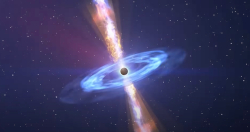Black holes are like the trap doors of the Universe - mysterious passageways to some dark fate which may befall you if you don't watch your step. The
nearest black hole to us is thought to be at a safe distance of about 1500 light years, but even so we're not quite confident that others may be much closer, lurking unseen to trap the unwary traveler, perhaps even
colliding with our planet. We now know that a number of stars have wandered close to black holes and suffered unfortunate ends: first torn apart by the tidal pull of the black hole (a process known by the technical term, "
spaghettification"), eventually swallowed by the black hole in an outburst of high energy radiation. Such outbursts are called tidal disruption events, and scientists have seen dozens over the past decade or so, aided by telescopic sky surveys specially designed to find things that go "blast" in the night. One such event was seen on February 14, 2022 by the
Zwicky Transient Facility located at the storied
Palomar Observatory, and was denoted
AT 2022cmc by astronomers. Observations showed that this object lay at an enormous distance, about 27 billion lightyears from earth. This enormous distance, and the brightness of the event as seen from earth, meant that the power of this flash was almost unimaginable, equivalent to the power output of the all the stars in about 1 million galaxies. What could create such a brief, powerful outburst of radiation? Followup X-ray observations with NASA's
NICER X-ray facility on the
International Space Station and NASA's
Swift observatory, and other instruments, showed that the AT 2022cmc burst likely originated in an extreme event: a star which wandered too close to a supermassive black hole, got torn apart, and formed a disk of matter around the black hole as it was slowly swallowed, producing a strong, particle beam jet which just happened to be pointed directly at earth. The image above is a
frame from an animation of the remains of the shredded star being slowly accreted by the monster black hole, along with the newly-formed particle beam.
 HEAPOW: Dead On (2022 Dec 05)
HEAPOW: Dead On (2022 Dec 05)
